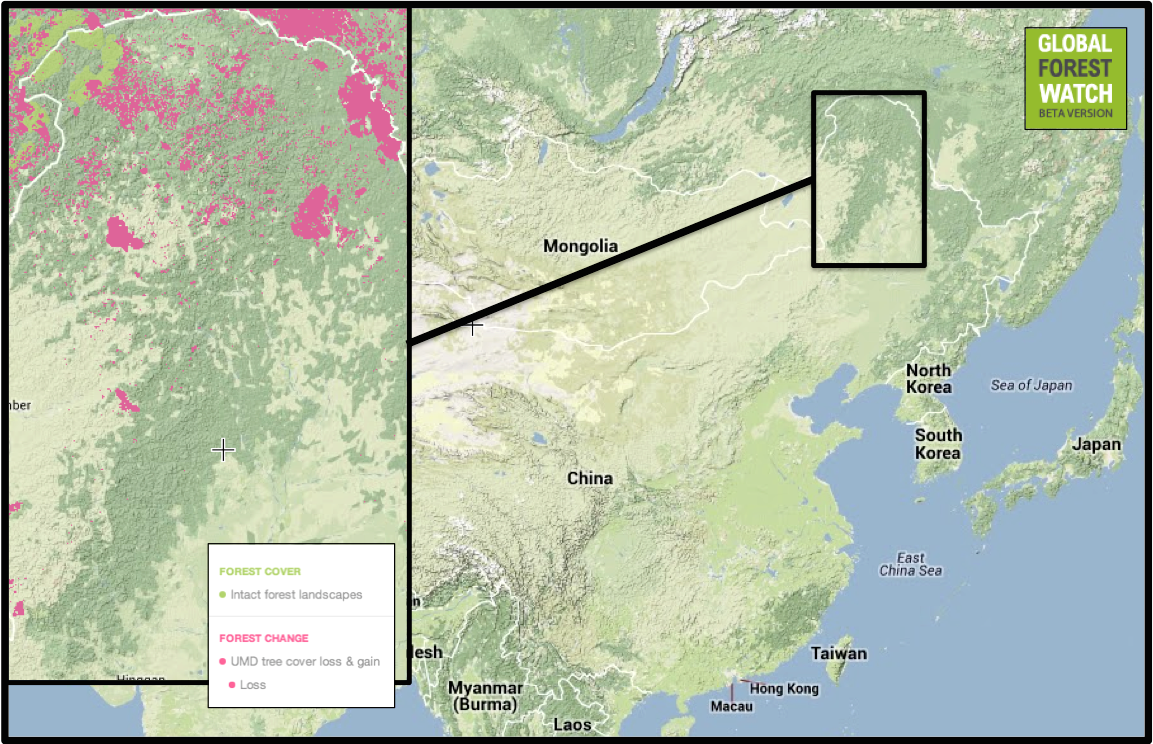Forestry authorities in China have stopped commercial logging in the nation’s largest forest area, marking an end to more than a half-century of intensive deforestation that removed an estimated 600 million cubic meters (21 billion cubic feet) of timber. The logging shutdown was enacted in large part to protect soil and water quality of greater China, which are significantly affected by forest loss in the mountainous region.
The area is in the extreme northeast portion of China, and comprises a huge swath of dense, temperate forest that stretches into Russia. The landscape is dominated by the Hinggan (Khingan) mountain range that spans more than 1,200 kilometers (750 miles) south towards China’s interior, and supports a diverse array of wildlife. The Hinggan Mountains also form an important climatic divide, taking precipitation from southeasterly winds and fueling watersheds that provide water to a tenth of China’s arable land.

Widespread deforestation in the Hinggan region from 2000-2013, represented in pink. The only intact forest is a small region indicated by light green in the upper left corner. Courtesy of Global Forest Watch. Click to enlarge.
Large-scale commercial logging of the area first began in the 1950s to meet growing economic demands. By the 1980s, the landscape of the region had changed dramatically due to the loss of forest cover, and large trees had all but disappeared. From 2000 to 2013 alone, more than half a million hectares of land were deforested in the region, according to data from Global Forest Watch. Logging activity was focused primarily in the northern periphery of the range, where around 20 percent of the land was deforested
Forests are vital to maintaining healthy watersheds. They help to catch water from the air, and they even provide it via their respiration processes. Additionally, their roots help to hold water in the soil. Without trees, droughts become more commonplace. When rain does fall on a deforested area, it isn’t released into streams gradually, but instead is discharged as a deluge, overwhelming streams and rivers. Without tree roots to bind them, riverbanks erode, sullying water and completely changing stream ecosystems. Downstream habitats that evolved to rely on a constant supply of water are often damaged by the feast-or-famine conditions brought about by deforestation.
The impacts of logging in the Hinggan range have been becoming increasingly evident, sparking major environmental problems.
“There are no longer any big trees. The winds in the Greater Hinggan Mountains are becoming stronger and the woods can no longer retain water,” Liu Zhanhun, a worker with the Qianshao Forestry Station, told Sina News.
“In the past, it rained for days before water levels in rivers could rise. Now the river water levels can rise substantially following just one rainstorm,” Liu said.
The Yalu River in the Greater Hinggan mountain range. Photo courtesy of Creative Commons Attribution-Share Alike 3.0.
In addition to droughts and floods, the total area of wetlands in the region has shrunk to half its original size, and forest fires have become more prevalent. In 1987, a fire of unprecedented size burned 10,000 square kilometers (3,900 square miles) of forest.
The rapid forest loss in Hinggan runs counter to the official narrative that China has eliminated deforestation through law enforcement measures and reforestation programs. According to Global Forest Watch, China lost some 6.1 million hectares of forest cover between 2000 and 2013, only 2.2 million hectares of which was offset by the establishment of new forests. Forest loss during this period was particularly concentrated in the southeastern part of the country, with a total loss of more than four million hectares.
In reaction to the growing crisis in the Hinggan range, China’s government began enacting protections of the area more than a decade ago while still allowing commercial logging. However, a forestry development plan warned that if logging were not stopped completely, the Hinggan forests could entirely disappear.
Yet, while many people are in favor of the ban, there are others whose livelihoods depend on the logging industry. A third of all Hinggan timber workers make only subsistence wages, and use wood to heat their houses during the frigid winters because they can’t afford to buy coal. In light of this, China’s government has earmarked $378.6 million (2.35 billion yuan) of annual aid for the workers, which will continue until 2020. Many communities are also considering the development of tourism industries for employment options.
Editor’s note: this post originally used “billion” instead of “million” when referring to the amount of money earmarked for timber workers. We regret the error.
Related articles
Illegal logging makes up 70 percent of Papua New Guinea’s timber industry

(04/22/2014) Corruption, weak governance, and powerful timber barons are illegally stripping the forests of Papua New Guinea, according to a new report from the Chatham House. The policy institute finds that 70 percent of logging in Papua New Guinea is currently illegal, despite the fact that 99 percent of land is owned by local indigenous communities.

(03/19/2014) Mongabay.org, the non-profit arm of environmental science web site Mongabay.com, has selected winners of three environmental reporting prizes under its Special Reporting Initiatives (SRI) program. The three prizes, which were launched in January, explore the impacts of rising human consumption on forest and marine ecosystems. The winners, selected from more than 150 applicants by a panel of issue-area experts, include Robert S. Eshelman, Ruxandra Guidi and Bear Guerra, and Dominic Bracco II and Erik Vance.
Alpine bumblebees capable of flying over Mt. Everest

(02/05/2014) The genus Bombus consists of over 250 species of large, nectar-loving bumblebees. Their bright coloration serves as a warning to predators that they are unwelcome prey and their bodies are covered in a fine coat of hair – known as pile – which gives them their characteristically fuzzy look. Bumblebees display a remarkably capable flight performance despite being encumbered with oversized bodies supported by relatively diminutive wings.
Investigation finds Chinese factory slaughters 600 whale sharks a year
(01/29/2014) A four-year investigation by WildLifeRisk, a Hong Kong-based marine conservation group, has found that a single factory in China’s Zhejiang Province slaughters some 600 whale sharks a year to produce oil for cosmetics and health supplements.
Hong Kong to destroy 4,000 dead elephants’ worth of ivory

(01/24/2014) The government of Hong Kong will destroy 28 tons of ivory confiscated from traffickers, reports CNN. The announcement, which comes just weeks after China destroyed six tons of seized ivory, suggests that the leaders of the world’s largest market for ivory may be getting more serious about addressing a global poaching boom, say conservationists.
